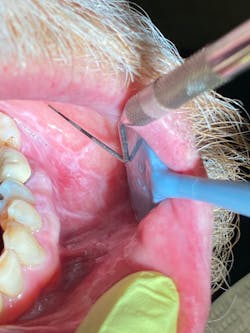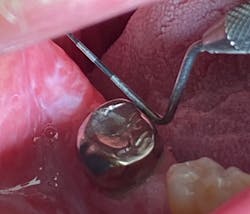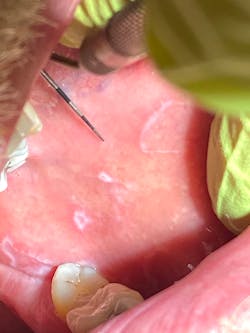Many of you have been asking about the “think on the fly” path case I presented recently. If you need a refresher, read all about it here. Here’s the lowdown…
As I suspected, the initial diagnosis for this patient was lichen planus (LP) with ulcerative tendencies, even though there were no real prominent ulcers presenting at the time. The burning in the mouth that the patient was experiencing was more or less what initiated suspicion of the diagnosis.
The OS had a lengthy discussion with the patient and subsequently recommended a biopsy to assure a definitive diagnosis. The patient declined. His reasons were personal, and according to the OS’s office, he was concerned about finances.
Here’s a quick refresher on lichen planus. LP is an inflammatory condition that affects the mucus membranes of the mouth. Symptoms of burning, itching, pain, and overall discomfort can range from mild to severe. LP is a T-cell autoimmune disease commonly found in the fourth decade of life, and it affects men more than women.1 The buccal mucosa, tongue, and gingiva are the most common oral areas affected.1
After seeing the OS, the patient stopped back by my office to discuss his concerns. I informed him that I had also talked to the OS about his case. The patient’s humble honesty about his reluctance to get a biopsy (aside from his financial situation) was because he didn’t want to put himself in a situation that could potentially compromise his ability to see to his wife’s needs. Simply put, she was his priority right now, and despite the simple nature of a biopsy, he didn’t want to consider it at this time.
His gratitude was evident when he brought me flowers (with his wife’s permission, of course), saying my help and advice showed him that I respected and genuinely cared about his situation—despite him not pursuing the recommended biopsy. He furthermore said that the Magic mouthwash was helping significantly. In that respect I couldn’t be happier and advised him of the continued need to monitor the lesions. The recommendation for the biopsy still stood. At that point, I’d done everything I could and considered the case a success.
This was not a medical textbook ending or one that I was initially hoping for, but not all treatment modalities or conclusions are what we want them to be. We must always remember that our patients have autonomy with respect to their bodies. It’s our job to advise, educate, refer, and share the pros and cons of all treatment options presented. And we must document, document, document.
And now you know the rest of the story.
For those of you wondering about the Magic mouthwash elixir I prescribed, here are the ingredients: one part viscous 2% lidocaine, one part Maalox, and one part diphenhydramine 12.5 mg/5 ml. 1–2 tsp. 2–3x/day prn. I will usually give 1–2 refills with a 150 ml bottle.
Cheers to the daily grind and the adventures along the way...
—Dr. Stacey
References
1. Lavanya N, Jayanthi P, Rao UK, Ranganathan K. Oral lichen planus: an update on pathogenesis and treatment. J Oral Maxillofac Pathol. 2011;15(2):127-132. doi:10.4103/0973-029X.84474
Editor’s note: This article first appeared in Through the Loupes newsletter, a publication of the Endeavor Business Media Dental Group. Read more articles at this link and subscribe here.
More pathology cases:










